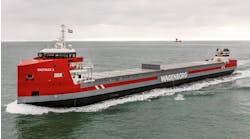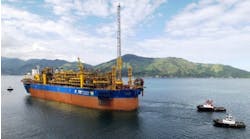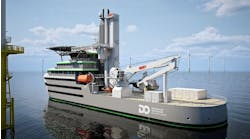Pride International began as a South Texas land rig contractor and now owns and operates a fleet of 57 offshore rigs and 251 land rigs in more than 20 countries. The company reported revenues of $830 million last year, its sixth consecutive year of record revenues. Pride acquired international deepwater experience in 1997 when it purchased the French company Forasol-Foramer.
Pride once had the most aggressive newbuild construction program in the industry, with eight newbuild vessels, two deepwater drillships, and six deepwater semisubmersibles - until two of the semisubmersibles were cancelled. Now, the company is tied with R&B Falcon for the most aggressive program with six - all capable of drilling in 5,000 ft water depths and all on long-term contracts.
In May, Pride christened the first of its new deepwater fleet, the Pride Africa deepwater drillship. The company intends to launch a sister vessel, the Pride Angola, in August, and next year, will christen four new Amethyst-class deepwater semisubmersibles.
One of the ways that Pride has been able to make such a massive surge into the market was by positioning itself in two of the hottest offshore markets.
The Pride Africa and Pride Angola are both under contract to Elf for five and three years, respectively, and will work offshore Angola, the hottest deepwater play in the world, specifically on Block 17, home of Girassol. In addition, the four Amethysts will go to work for Petrobras offshore Brazil, the leading deepwater exploration front.
Joint venture
One technique that Pride has used to make such a strong move into deepwater is the establishment of joint ventures with operators to help mitigate risk and cover some of the financial burden of the vessels. The use of joint ventures is a growing trend with some of the drilling
contractors, the most notable being the R&B Falcon-Conoco joint venture for the Deepwater Pathfinder and Deepwater Frontier drillships.
For Pride, the use of joint ventures is not new. John O'Leary, Vice President Worldwide Marketing for Pride and a joint venture specialist, said, "We have been in joint ventures for the past 20 years. We have been doing it because it made sense, not because it was fashionable. Our approach to any market is to create a meaningful presence and stay for the long term."
Pride has done so through two joint ventures set up for the financing of its six deepwater rigs. In Brazil, Pride has an agreement with Maritima Petroleo e Engenharia for the construction and operation of the four Amethyst semisubmersibles. And for the two drillships, Pride has established a joint venture company called Sonamer with Sonangol, the state oil company of Angola.
Sonamer is owned 51% by Pride and 49% by Sonangol and was set up for the ownership of the rigs. Sonamer has appointed Pride as the manager of the rigs for and on behalf of the joint venture and Pride has the contract with Elf for the operations. O'Leary said, "It is a bona fide joint venture with each participant taking a share of the risks and the rewards and each party contributing its share of the capital in cash. Both are contributing to the construction of the vessel.
"Given the long-term nature of the deepwater play offshore Angola, it would seem that having a partner like Sonangol gives us a strategic advantage. Secondly, Sonangol was anxious to take a part in the upstream service side of the business, and they chose a contractor they have been dealing with since the early 1980s."
In essence, this does offer Pride a strategic advantage in Angola. In the event of another downturn where rigs begin to be stacked, having the support of the state oil company adds some cushion to the operating life of the rig. In other words, the chance that Sonangol will stack a rig in which it holds a large stake is very small.
Gusto Engineering
Under the name Sonamer, Pride and Sonangol have christened the first of their fleet at the Hyundai MIPO construction yard in Ulsan, South Korea in May. Manuel Vicente, Chairman and CEO of Sonangol decreed the drillship, "the most technologically advanced vessel in Africa." The vessel represents the first newbuild to grace West African deepwater.
The design of the drillship came from Gusto Engineering, a company with which Pride has a long history. Gusto is a division of the IHC Group, a shipyard, and a shareholder of Foramer until the early 1990s. In the early 1970s, Gusto designed the Pelican-class drillship, one of the pioneering DP drillships and the most widely used drillship design in the industry. Foramer played an integral part in the design process with the incorporation of the drilling equipment.
In 1986, Gusto and Foramer again set out to develop a new generation of drillship aimed at harsh environment. This developed into the Super Gusto design, but the poor market forced the design to be shelved. However, in the mid-1990s, Gusto again set out for a new design based on this Super Gusto ship shape.
At the same time, Foramer began examining deepwater operations and found the hull of the Anadyr, a Russian submarine carrier. Gusto incorporated the hull in the new design and modified it for drilling operations, based on the specific load curves and motion characteristics needed. The Gusto 10000 drillship design emerged as the hull for the Pride Africa and Pride Angola.
Hyundai MIPO
The vessel was built at the Hyundai MIPO yard in Ulsan, South Korea. MIPO is the refurbishment yard for the Hyundai Heavy Industries (HHI) shipyard, a leading fabricator for product tankers, floating production units, and LNG carriers. MIPO handles the smaller vessels, while HHI handles the larger ships.
MIPO is equipped with four drydocks, two for ship repair and two for newbuilding. This adds flexibility and allows it to utilize other docks to increase capacity when necessary. MIPO merged the Anadyr hull with newbuilt fore and aft ends to create the hull of the drillship and was able to complete construction in 18 months, on time and under budget. The second vessel, Pride Angola, is nearing completion. Delivery is expected to be on time, if not earlier, in addition to being under-budget.
Pride and MIPO attribute the timeliness of this delivery to the yard's focus on refurbishment. J.I. Lee, President and CEO of MIPO, said "the fact that Hyundai MIPO was a refurbishment yard allowed the workers to adapt quickly to changes. Drillships usually have a minimum of 10-15% of additional work and changes. This vessel contained about 10%."
Pride Africa
The Pride Africa cost $235 million and was completed in 18 months. The vessel is under a five-year contract to Elf for work on Block 17 offshore Angola. The day rate on the contract is $162,000/day. The vessel was designed to operate in 10,000 ft water depths, but is outfitted for 6,000 ft at the request of Elf.
The sister vessel, Pride Angola, will be identical in design and outfitting. The drillship will also work for Elf under either a three-year or a five-year contract. Elf will decide the contract length before the ship goes into operation. Currently, it is a three-year contract with two, one-year options. Pride Angola will also be outfitted for 6,000 ft, but Pride is now in negotiation with Elf for equipping the vessel to its full 10,000-ft capability.
Pride Africa measures 680 ft in length by 98.5 ft in breadth. The vessel is rated for 10,000 ft maximum water depth operating capability, but is outfitted to 6,000 ft at the request of Elf. Pride Africa has a design draft of 32.8 ft and 41,000 metric ton displacement.
The contractor designed Pride Africa without a large amount of prototype equipment and concentrated on three things: drilling, zero downtime, and efficiency. Thomas Duhen, Technical Director of Pride, said, "there are a few technical improvements and some of the equipment is prototype. Every system consists of equipment that is commercially available from vendors, but there is a large amount of equipment, which is the latest commercial equipment. We wanted to have a good balance of proven equipment, proven procedures, and the introduction of new technology. We did not want to go for revolutionary design with major changes in the way the operations are run. We expect zero downtime from day one."
The vessel was designed for drilling from the start. "Gusto designed a hull with a drilling load curve around the moonpool which is designed for drilling operations and running subsea wellheads, Duhen said. "This is not the same as the other designs in the market because these are conversions from tankers, or from other vessels for other applications. These vessels were not initially designed for drilling load curves, but the Pride Africa is."
As far as the vessels' technical capabilities, both have a unique dual handling system that allows for the preparation of the stands of pipe, casing up to 9 5/8 in., tubing from 2 7/8 in. up to 7 in., or bottom hole assemblies up to 12 1/4 in. while drilling. The system picks up the stands, applies full torque, and stores them in the racking system until needed. The dual handling system is controlled from the driller's cabin where there are three chairs: one for the dual handling operations, one for the driller, and one for the assistant driller. All three chairs are equivalent and redundant.
Pride has estimated massive time and efficiency savings from this system. "We have estimated that we can save 50% of the handling operations, which accounts for 40% of the total time when we are in drilling mode," Duhen said. "This equates to a 20% saving of the total time of drilling operations."
In addition to the dual handling, the vessel is equipped with seven retractable thrusters that provide 21,400 kW of thrust power. These include two azimuthing propulsion thrusters, three additional azimuthing thrusters, and two bow tunnel thrusters. The retractable feature allows for inspection and maintenance to be performed on the thrusters while in operation. This also enables the vessel to retract the thrusters on long voyages to reduce drag and access shallow water ports.
Guy Devos, Pride Africa's captain said the vessel, "has a great deal of thrust in the bow, and power in the front - good for heading strong winds. It is not limited in severe weather." The vessel is dynamically positioned in the DNV AUTR class, between DPS 2 and DPS 3 of the ABS classification. AUTR means that the vessel has redundancy and two power plants and can stay on location if two of the thrusters are lost.
The vessel is also equipped for storing and running subsea wellheads. The wellheads can be stored on a cellar deck, which can accommodate the largest christmas tree in the industry and the motion characteristics of the vessel were also optimized for the running of the wellheads.
For the riser, Pride chose a lighter 21-in. riser supplied by Kværner. The riser was developed 18 years ago by IFP in France. The light weight of the riser offers a low exposure to the current and features a unique "clip" connector that allows for faster operations.
The vessel will be the most "technologically advanced vessel in Africa", and suitable to begin deepwater operations in the hottest offshore play in the world.
Pride Africa is undergoing additional sea trials to test the drilling and subsea equipment of the rig. The vessel will arrive on location in Angola next month and Pride's deepwater ability will be put to the test. Within 12 months, five more vessels will enter Pride's fleet and establish the company as one of the top players in the deepwater market.


